The trap function for the OSPF module is enabled.
To enable all non-excessive traps of OSPF module, you can run the non-excessiveall command;
to enable the traps of one or more events, you can specify type-name.
----End
4.12.4 Configuring OSPF Log
Logs record the operations (such as configuring commands) and specific events (such as the
network connection failure) on switches.
Context
Do as follows on the OSPF switch:
Procedure
Step 1 Run:
system-view
The system view is displayed.
Step 2 Run:
ospf [ process-id ]
The OSPF process view is displayed.
Step 3 Run:
enable log [ config | error | state | snmp-trap ]
The log function is enabled.
----End
4.12.5 Checking the Configuration
After the network management function is configured for OSPF, you can check the contents of
the information channel, information recorded in the information center, log buffer, and trap
buffer.
Prerequisites
The configurations for the network management function of OSPF are complete.
Procedure
l Run the display ospf [ process-id ] brief command to view information about the binding
of OSPF MIBs and OSPF processes.
l Run the display snmp-agent trap feature-name ospf all command to view all trap
messages of the OSPF module.
----End
S6700 Series Ethernet Switches
Configuration Guide - IP Routing 4 OSPF Configuration
Issue 01 (2012-03-15) Huawei Proprietary and Confidential
Copyright © Huawei Technologies Co., Ltd.
134

